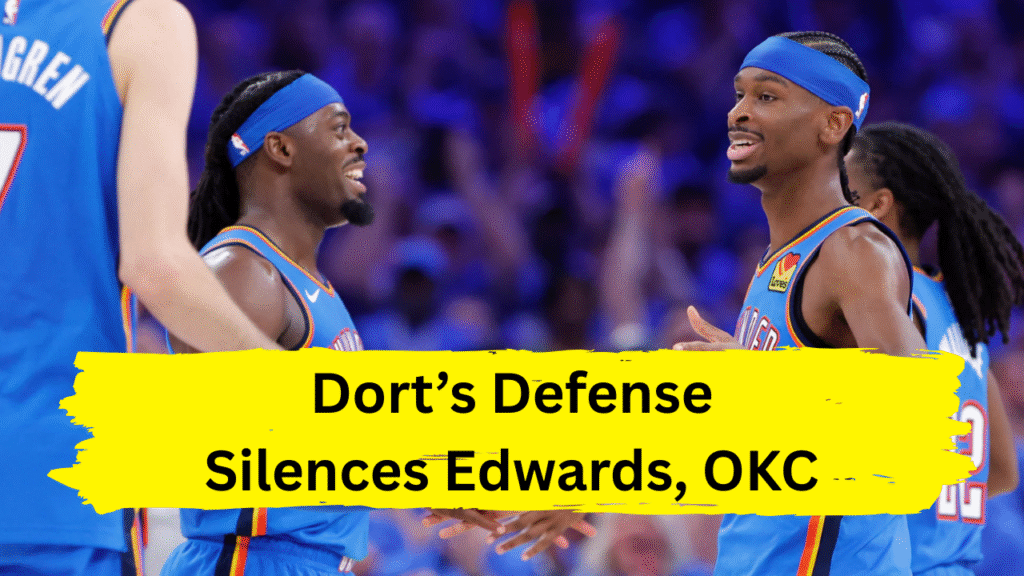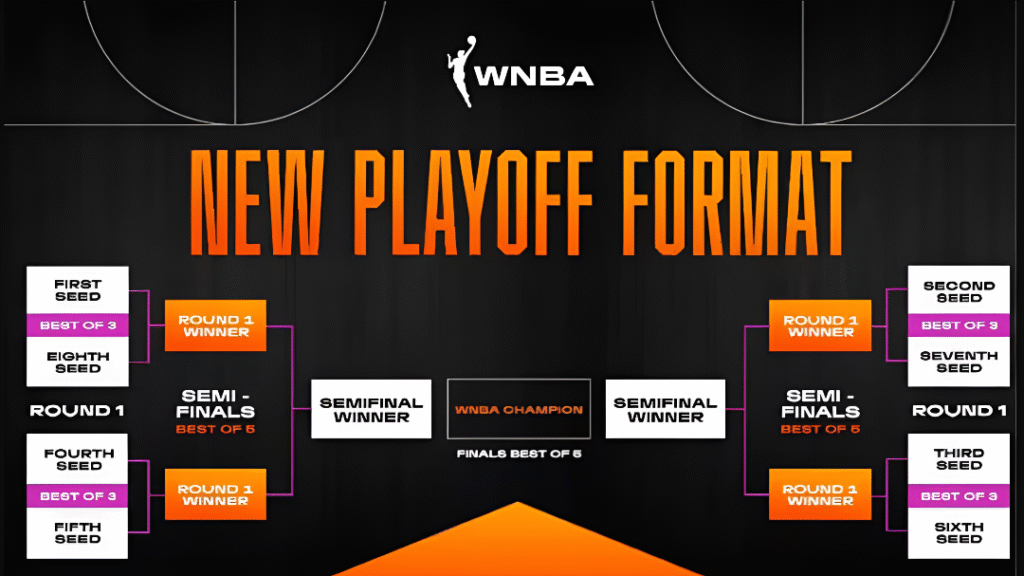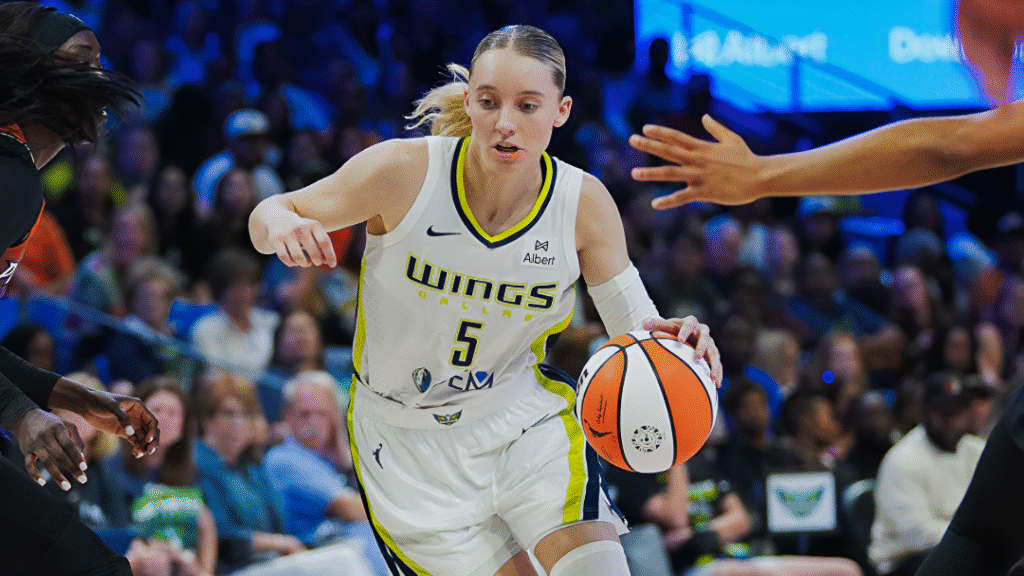In a pivotal Game 4 of the Western Conference Finals, the Oklahoma City Thunder delivered a defensive masterclass, stifling Minnesota Timberwolves star Anthony Edwards and tilting the series in their favor. While Shai Gilgeous-Alexander’s 40-point spectacle dominated headlines, the Thunder’s victory was equally defined by their suffocating defense—spearheaded by Luguentz Dort—that neutralized Edwards, one of the NBA’s most explosive scorers. This breakdown explores how OKC’s strategic adjustments and Dort’s relentless execution turned Edwards from a playoff juggernaut into a non-factor, paving the way for a 128-126 win and a commanding 3-1 series lead .
The Blueprint: Early Aggression and Denying Comfort
From the opening tip, the Thunder executed a game plan designed to disrupt Edwards’ rhythm. Dort, a First-Team All-Defensive selection, set the tone by hounding Edwards with full-court pressure and denying him easy touches. Minnesota’s star didn’t attempt his first field goal until the final minute of the first quarter, a testament to Dort’s ability to navigate screens and stay glued to his assignment . This aggressive approach forced Edwards into passive decision-making, limiting him to just two shot attempts and four points in the first half.
The Thunder’s strategy extended beyond individual defense. Oklahoma City employed early double-teams and clogged driving lanes, funneling Edwards toward help defenders like Chet Holmgren, who lurked near the rim. By cutting off his preferred paths to the basket, OKC forced Edwards into contested jumpers or rushed passes—a stark contrast to his dominant 30-point outburst in Game 3. The result? Edwards finished with 16 points on 5-of-13 shooting, including a dismal 1-of-7 from three-point range .
Dort’s Relentless Physicality
Dort’s reputation as a defensive stopper was on full display. His physicality and lateral quickness disrupted Edwards’ timing, preventing him from establishing a scoring rhythm. Minnesota’s star, who thrives on downhill drives and mid-range pull-ups, found himself repeatedly funneled into crowded areas or stripped of the ball. Edwards committed seven turnovers, many of which stemmed from Dort’s active hands and anticipatory positioning .
Crucially, Dort’s effort never wavered. Even when Edwards attempted to exploit mismatches by switching onto smaller defenders, OKC’s rotations were swift. Alex Caruso, another defensive catalyst, emphasized the team’s collective mindset: “It’s a five-person job. … We gotta be anticipatory and in the spots we’re supposed to be before he starts attacking” . This synergy ensured Edwards faced a wall of defenders every time he touched the ball, eroding his confidence and forcing the Timberwolves to rely on secondary scorers.
Team Defense: Rotations and Forced Errors
While Dort anchored the perimeter, the Thunder’s defensive scheme thrived on disciplined rotations and communication. Chet Holmgren’s rim protection loomed large, as his three blocks—including a critical swat late in the fourth quarter—discouraged Edwards from challenging the paint . Meanwhile, Jalen Williams and Cason Wallace provided timely help, closing gaps and contesting shots without overcommitting.
The Thunder also capitalized on Minnesota’s sloppy ball handling. By pressuring Edwards and Julius Randle (five turnovers), OKC forced 23 total turnovers, converting them into 22 points . These live-ball errors disrupted the Timberwolves’ offensive flow and allowed the Thunder to push the pace, negating Minnesota’s bench scoring advantage (64-27) .
Psychological Warfare: Breaking Edwards’ Rhythm
Beyond physical execution, OKC’s defense targeted Edwards’ mental game. The Thunder’s swarming tactics forced him into uncharacteristic hesitancy. Instead of attacking decisively, Edwards often settled for passive passes or off-balance shots, a trend highlighted by his six assists overshadowed by inefficient scoring . Postgame, Edwards downplayed his struggles, crediting OKC’s defensive schemes: “They did a good job … every time I had the ball, they showed me a major crowd” .
The Thunder’s ability to adapt after a disastrous Game 3 also played a role. After allowing Edwards to torch them for 30 points in a 42-point blowout, OKC tightened their rotations and prioritized early help defense. This adjustment left Edwards searching for answers, as his trademark explosiveness was neutralized by calculated defensive positioning .
The Ripple Effect: Minnesota’s Offense Unravels
By shutting down Edwards, the Thunder exposed Minnesota’s overreliance on their young star. With Randle similarly stifled (five points on 1-of-7 shooting), the Timberwolves’ offense devolved into isolation-heavy sets, despite strong bench contributions from Nickeil Alexander-Walker (23 points) and Donte DiVincenzo (21 points) . Oklahoma City’s defensive intensity cascaded through Minnesota’s roster, as role players like Jaden McDaniels (22 points) were forced into unfamiliar shot-creating roles .
Conclusion: A Defensive Masterclass with Championship Implications
The Thunder’s Game 4 victory wasn’t just a showcase of Shai Gilgeous-Alexander’s MVP-caliber talent—it was a testament to their defensive identity. By blending Dort’s lockdown prowess, Holmgren’s rim protection, and cohesive team rotations, OKC transformed Anthony Edwards from a playoff phenom into a frustrated bystander.
As the series shifts back to Oklahoma City for Game 5, the Timberwolves face a near-impossible task: reigniting Edwards’ fire against a defense that has solved him. For the Thunder, this performance underscores their championship pedigree—a blend of youth, adaptability, and defensive tenacity that could soon propel them to the NBA Finals . In a league increasingly defined by offensive firepower, OKC’s shutdown of Edwards serves as a reminder that defense still wins when it matters most.


